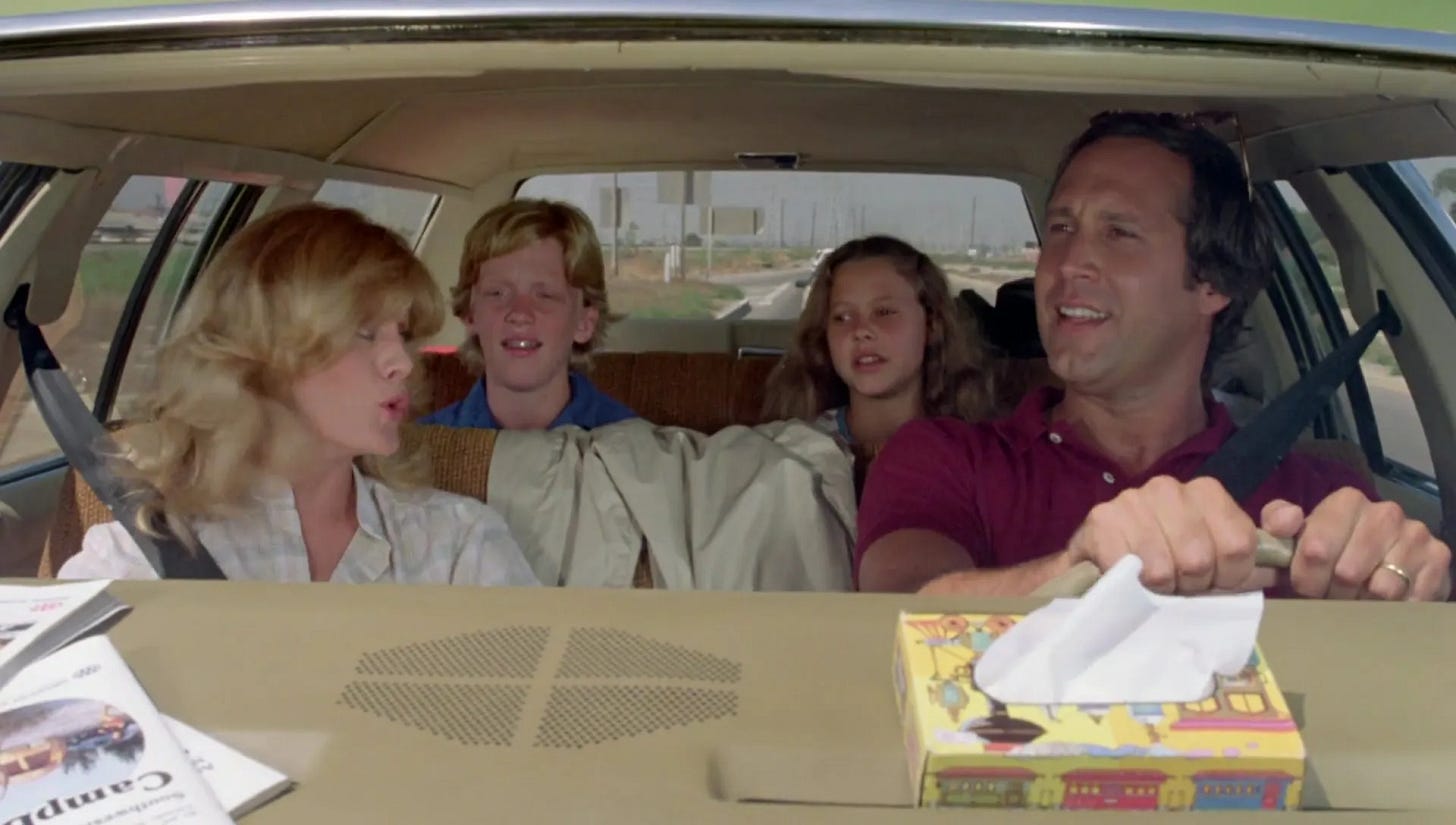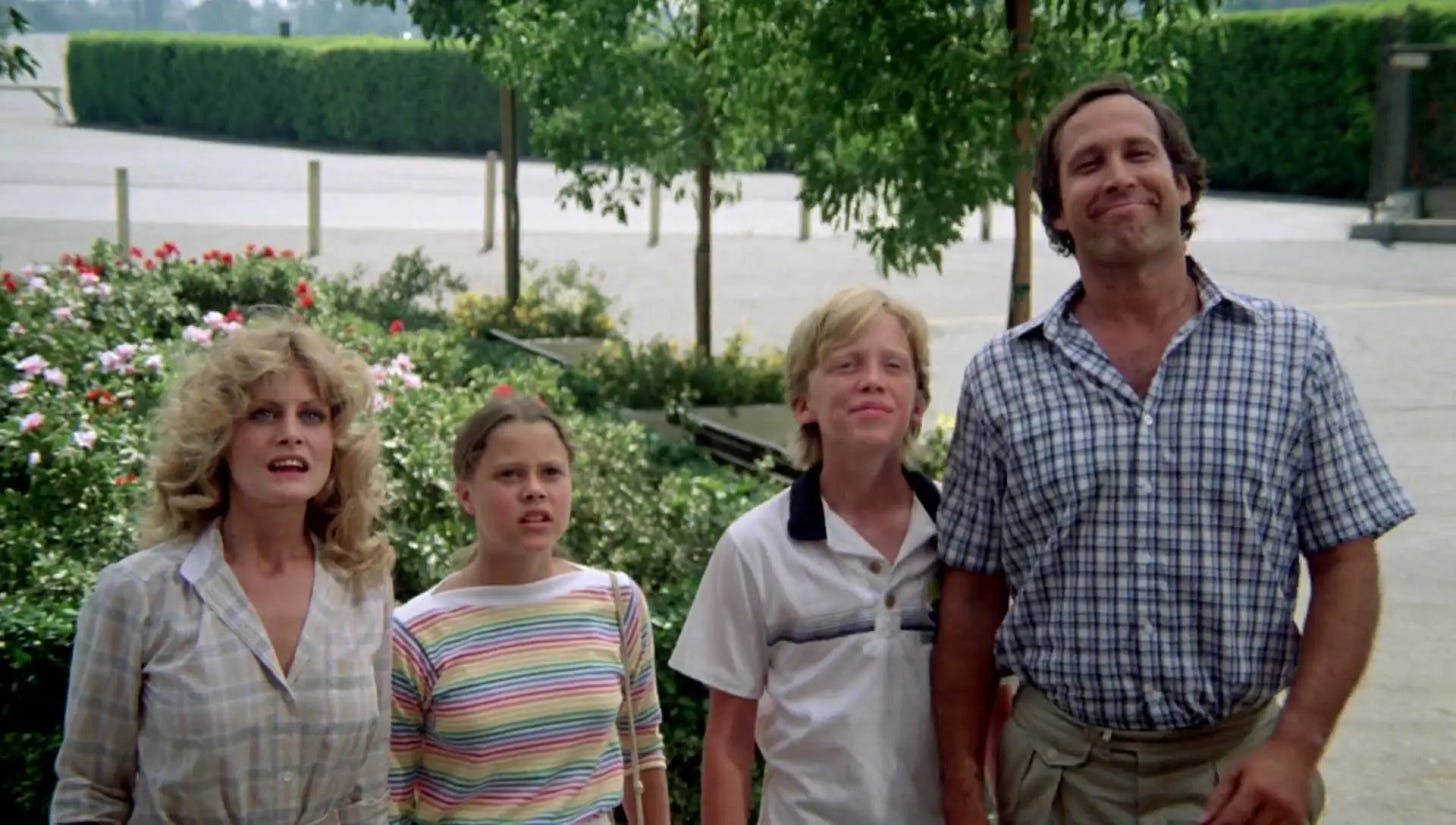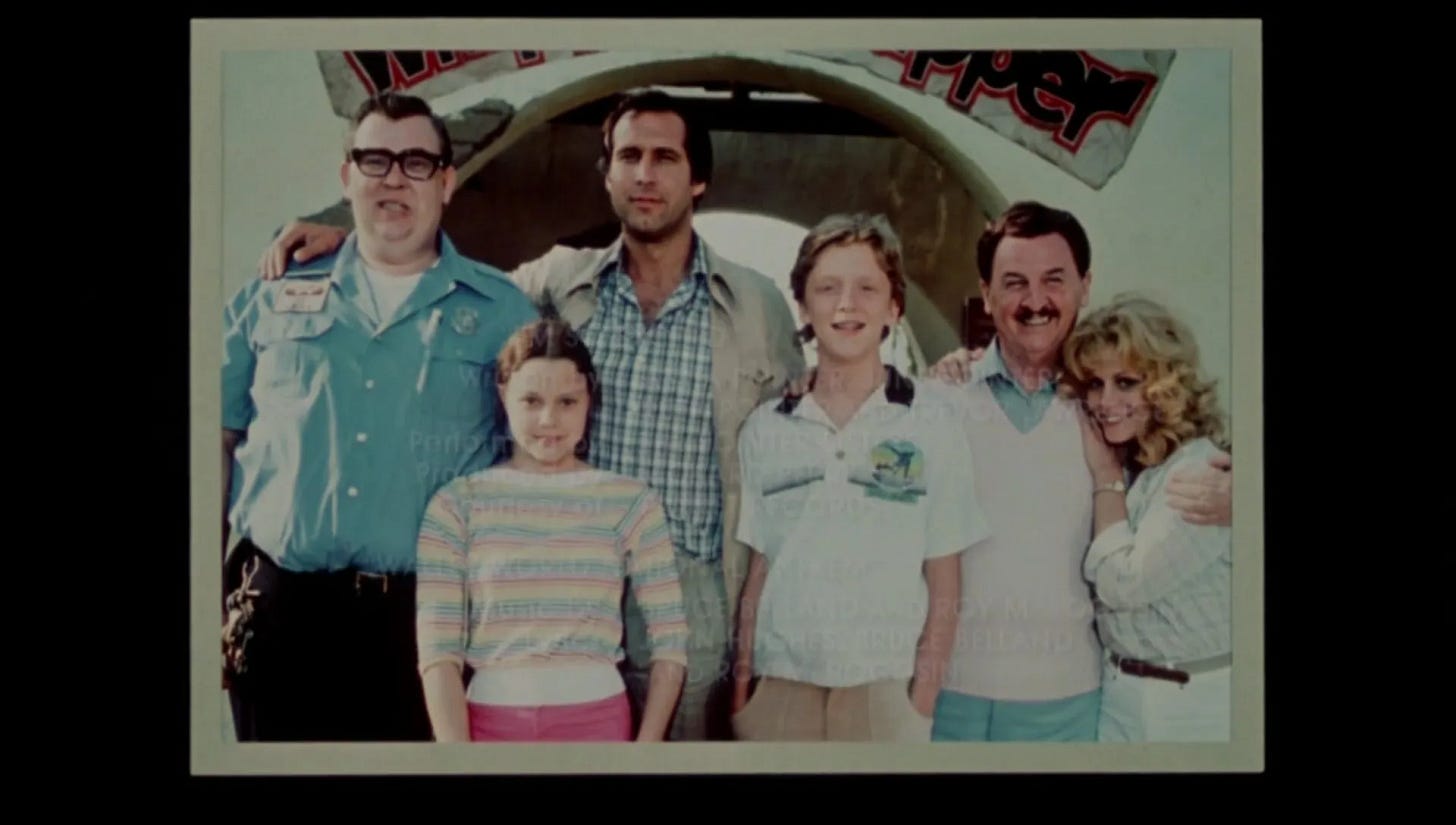National Lampoon's Vacation
Poorly aged jokes overwhelm characters in John Hughes-scripted comedy
For the remainder of summer, Video Days piles in a vehicle and for those who can’t take a vacation, journeys to unfamiliar places with comedies about strangers in strange lands.

NATIONAL LAMPOON’S VACATION (1983) takes what began as a demented and somewhat dark account of a 13-year-old boy’s family road trip–fit for print by National Lampoon magazine in the 1970s–and over-exposes it in the 1980s for the big screen in a broad, occasionally crass and totally phony comedy. The filmmakers skate by on nostalgia, recreating situations we do recognize from the family road trips of our childhood, putting in motion a movie in our head that makes this one seem pretty good by association. It isn’t.
According to legend, John Hughes wrote the short story Vacation ‘58 over a four-day period in which Chicago was blanketed by a blizzard in the late seventies, inclement weather giving the ad copywriter and later creative director for Leo Burnett Co. nowhere to go and nothing else to do. Hughes was already freelancing as a writer, submitting jokes to comics like Rodney Dangerfield and Phyllis Diller, and contributing humor pieces to Playboy magazine, which assigned him their first ever “20 Questions” interview, with model Cheryl Tiegs, in 1978. According to his son James, the prize was National Lampoon magazine, which branched out from the venerable Harvard Lampoon in 1970 to sharpen a style of aggressively smug satire in print, theater and radio (the magazine’s editor-in-chief in 1978 was P.J. O’Rourke). Vacation ‘58 would be bumped from the August 1979 vacation issue to publish the following month in an issue of also-rans that had been passed over for print, but Hughes was so fulfilled contributing to the magazine that he quit Leo Burnett and with a six-month old son, accepted roughly half his advertising salary to write full-time for National Lampoon.
Hughes’ productivity landed him a staff position as one of five or six writers or editors chiefly responsible for putting out a new National Lampoon each month. The moment Hughes arrived, the magazine’s publisher Matty Simmons had cannonballed into film, producing National Lampoon’s Animal House (1978) with Ivan Reitman. Only two other movies–Grease and Superman–would sell more tickets than Animal House that year. Vacation ‘58, while irreverent, wasn’t a tale of debauchery, but of a 1950s family road trip, narrated by a 13-year-old boy from Grosse Pointe, the Detroit suburb where Hughes had grown up before his family moved to Chicago when he was thirteen. Riding high on Animal House, Universal Pictures gobbled up a pitch from Simmons and producers Richard D. Zanuck and David Brown, producers of Jaws (1975), for a spoof sequel which Simmons called Jaws 3, People 0. Simmons wanted Hughes to co-write the script with another Lampoon writer, Tod Carroll. The studio spent nearly $2 million and a full year prepping the movie until studio president Ned Tanen abruptly pulled the plug–as Simmons would later claim–at the request of Steven Spielberg, apparently okay with his film being ripped off, but not mocked in name.
Hughes paralleled from Jaws 3, People 0 to write a send-up of slasher movies from his own story. Titled Class Reunion, Hughes couldn’t interest Simmons in his script, but did win permission from the publisher to use the National Lampoon name to set the project up, at ABC Motion Pictures. Simmons was completing National Lampoon Goes to the Movies, a portmanteau satirizing a bucket of film and TV genres. Completed in 1981, drastically cut and finally released–as National Lampoon’s Movie Madness–a year later, the movie was an embarrassment. When ABC dismissed the producer of Class Reunion, Simmons reluctantly came aboard to produce what would be John Hughes’ first screen credit, as writer. Riding high expectations, Class Reunion opened over the 1982 Halloween weekend and sank without a trace, savaged by angry critics and kneecapped by dismal word of mouth, audiences pouring in to see E.T. the Extra-Terrestrial for the third time instead. When Class Reunion was released on home video, “National Lampoon” had been dropped from the title. Seeking to recapture the magic of Animal House, which had been based on a short story by Chris Miller published by National Lampoon in 1974 as The Night of Seven Fires, Simmons returned to his magazine for film material. He’d always thought that Vacation ‘58 would make a good movie.
Producer Matty Simmons’ first stop with Vacation ‘58 was Paramount Pictures, whose president of production Jeffrey Katzenberg struggled to connect with the episodic nature of the material and passed on it. Simmons found an advocate with Mark Canton, an executive VP at Warner Bros. who’d worked with Animal House co-writer Harold Ramis on his directorial debut, Caddyshack (1980). Canton wanted to make a National Lampoon movie at Warner Bros. and sold his bosses Robert Daly and Terry Semel on optioning Vacation ‘58 as that movie. Simmons commissioned John Hughes to adapt his short story into a screenplay, which according to another legend, he completed in four days too. Canton passed Hughes’ script to his choice of director, Harold Ramis, who thought it very good. The patriarch in Hughes’ original story and script was similar to the dad in A Christmas Story (1983), a grandiose buffoon at times but given to losing his temper, quite intimidating to a boy. The first actor Ramis thought of was Chevy Chase, who he’d directed in Caddyshack. Chase had graduated from the debut season of Saturday Night Live in 1976-77 to play smug smart alecks in a number of comedies. His last three as the star–Oh! Heavenly Dog (1980), Under the Rainbow (1981) and Modern Problems (1981)--had been abysmally reviewed and, at best, marginally successful at the box office.
Chase had already turned Simmons down once, opting to make his leading man debut opposite Goldie Hawn in Foul Play (1978) rather than join the ensemble of Animal House, the role of Otter going to Tim Matheson. Receiving assurances from Ramis that they could address his concerns by rewriting the script together, Chase agreed to star in National Lampoon’s Vacation. Ramis conceded that rather than the boy–now named Rusty Griswold–he was more interested in Clark, a man who had two weeks a year to be the perfect husband and father. With Chase in the room offering input, Ramis touched up the script to make cheerful optimism–not hair-triggered anger–Clark’s defining trait. Another change was the vacation route. Hughes had taken the Griswolds from Kansas down into Oklahoma, the Texas Panhandle and New Mexico. Ramis jumped from Cousin Eddie’s farm to the state of Arizona, where the Grand Canyon and Monument Valley offered him visually compelling topography. The road trip climaxed at “Walley World,” a Los Angeles amusement park. In Hughes' script, after the Griswolds find the park closed for repairs, Clark crashes the Family Truckster into the estate of Roy Walley, forcing the CEO and his minions to sing and dance for them as compensation. The police take the Griswolds into custody, but when Walley hears what the family went through to visit his park, he drops the charges. Boarding a flight home with hats that suggest they got to Walley World after all, the Griswolds’ bad luck continues when the pilot announces a change in course.
Ramis, Simmons, the casting director and studio had different preferences for who would play Clark’s wife, Ellen. According to Simmons, Beverly D’Angelo was his choice and she accepted the part. To play their kids, Anthony Michael Hall and Dana Barron were cast. Hall had played Huckleberry Finn in a made-for-TV sequel to the Mark Twain books and had made his film debut as part of the pint-sized ensemble of the Kenny Rogers comedy Six Pack (1982). Barron was the daughter of Robert Barron, co-founder of Weist-Barron School of Television, a commercial and soap opera acting school in New York, Dana working in commercials and theater. Filling out the cast were Imogene Coca, Randy Quaid, John P. Navin Jr. and Jane Krakowski (as Rusty and Audrey’s country cousins Dale and Vicky), Eugene Levy, James Keach, and Eddie Bracken. Supermodel Christie Brinkley appeared in four scenes, including one in which she appears to be skinny-dipping in a hotel pool with Clark. Billed as “The Girl in the Ferrari,” Brinkley’s presence in the movie was so far-fetched that fans would theorize that she was playing Roy Walley’s daughter–hence the Ferrari and the direction she’s headed–and that she was responsible for convincing him to drop the charges against the Griswolds. The filmmakers denied there was anything that deep to Brinkley’s character.

To play the “Wagon Queen Family Truckster,” five ‘79 Ford LTD Country Squires were bought and modified for the show. Once he became a director, John Hughes would apply the same pea green paint and wood siding to what he called a “Gran-Detroit Farm & Country Turbo,” the convertible sedan Steve Martin and John Candy get stuck with in the road comedy Planes, Trains and Automobiles (1987). National Lampoon’s Vacation commenced shooting in July 1982 in Boone, Colorado, which stood in for rural Kansas in the Cousin Eddie scenes. The movie would be shot mostly in Colorado and the Los Angeles area. “Lou Gultz Motors” was filmed outside Glendale Chrysler and Jeep in Glendale (with mountains visible in the background for what is supposed to be Chicago), while exteriors for the Griswold homestead were shot in Los Feliz. The rough side of St. Louis was spoofed on the Warner Bros. backlot. The picnic scene featuring Brinkley was filmed at Shaw Creek Rest Area in South Fork, Colorado. The hotel where Chase and Brinkley cavort in the pool was filmed near Los Angeles, at the Hotel Saddleback in Norwalk.
The Walley World parking lot and entrance were filmed at Santa Anita Racetrack in Southern California, the park’s massive signage faked with matte paintings by Hoyt Yeatman’s group at Dream Quest Images. Ramis would recall that when National Lampoon’s Vacation was put before a test audience, the raucous laughter of the first 80 minutes went silent and never returned once the Griswolds invaded the home of Roy Walley. Though the filmmakers found it amusing, they hadn’t anticipated viewers investing in the road trip so much they wanted to see the Griswolds make it to Walley World. The director turned to John Hughes to bail them out. In Hughes’ new ending, Clark takes a security officer hostage at BB gunpoint and forces him to take his family on the rides before Roy Walley and the police arrive. Bill Murray was offered the part of the security officer and declined, but Warner Bros. was so buoyed by the response to the rest of the picture that they paid John Candy $1 million to cameo. Shot at Six Flags Magic Mountain in Valencia, California six months after production had wrapped, Anthony Michael Hall calculated he’d grown at least four inches when he returned to film the new ending.

National Lampoon’s Vacation opened the last weekend of July 1983–one week after the John Hughes-scripted Mr. Mom debuted in limited release–in 1,175 theaters in the U.S. Vacation held the #1 spot at the box office for three consecutive weekends and positive word-of-mouth kept it among the top ten grossing films for twelve weeks, the biggest hit of Chase’s film career. Mr. Mom, starring Michael Keaton as a Detroit auto engineer who loses his job, would pick up where Vacation left off, expanding to 1,235 theaters and holding #1 for five straight weekends. Both scripts altered by others to accommodate Chevy Chase and (in Mr. Mom) Teri Garr, Hughes declared he’d learned that screenwriters had no control over their material. By November, he’d finished shooting his directorial debut Sixteen Candles (1984) and was in pre-production on The Breakfast Club (1985). As for Vacation, critics leaned positive. Gene Siskel & Roger Ebert rendered a split decision. Siskel thought the whole film worked, crediting the writers (the WGA awarded writing credit to John Hughes) and also Chase for finding a role that allowed him to settle back and not force himself on the audience. Ebert liked the first half of the movie, feeling it turned into too much of an Ozzie and Harriet episode for him to recommend. Janet Maslin, in her endorsement in the New York Times, credited Vacation for being more focused than the prior National Lampoon movies. “The result is a confident humor and throwaway style that helps sustain the laughs–of which there are quite a few.”
There are well-earned laughs in the original Vacation, which is more than can be said for the sequels. Anthony Michael Hall, cast as an audience surrogate–as he, like we, observe disaster unfolding–comes across as a genuine junior high school kid in his first major film role, not speaking much, or when around adults, even acting up much, but observing. When he does speak, Hall delivers a knowing dead pan to perfection. In Hall, John Hughes found a wonderful embodiment of his experiences and personality quirks for the first three pictures he directed, and Hall was a discovery here. Simmons and Ramis were also fortunate to get Beverly D’Angelo, who demonstrates in small doses what a flexible performer she is, and bring in Randy Quaid, Eugene Levy and John Candy to pinch hit for a couple of scenes. As for Chevy Chase, his gift for physical comedy can’t be denied, and his bumbling moments are money in the bank. One criticism is that Ramis allows Chase too much autonomy in his scenes opposite Quaid and Candy, as well as D’Angelo, all reduced to standing around while Chase fiddles with a car antenna, BB gun or dishes, focused on getting his laughs at the expense of the ensemble.

Neither Hughes or Ramis had much screenwriting or directing experience on Vacation, and it shows. As writers, they’re quick to go for the joke rather than dig into what would happen if their situation were playing for real. In a moment at home when Clark is trying to share his itinerary with his family, instead of showing his wife and kids too absorbed in their own lives to care, or develop why this vacation means so much to Clark, Hughes and Ramis use this as an opportunity for a Pac-Man sight gag which hasn’t aged well or even corresponds to known computer science. In the crassest scene in the movie, Clark takes a wrong turn in St. Louis and drives his family into the ghetto, where pimps, prostitutes and thieves adorn the scenery like a Ralph Bakshi cartoon. Nothing happens to the Griswolds that remotely would in a situation like this, where they’d be more scared than they had reason to be. The joke is that Black people steal hubcaps. Imogene Coca is miscast as what is supposed to be an old bat out of hell, written and directed merely as aged and cranky, her character not enough of an obstacle to Clark’s mission. The joke is that we all have an awful relative and how funny would it be if she died on the road. The strength of Vacation is how topical or relatable it is–family trips that turn tedious, Dad getting lost, a visit to country cousins–but by shifting the focus away from the 13-year-old boy and onto jokes at the expense of his buffoonish dad, the filmmakers take a turn toward the superficial.
Video rental category: Comedy
Special interest: On the Road










Hey, good morning Joe! I enjoyed this movie, but yeah, it felt like a lot of SNL bits strung together… However, some of those bits had me doubled over almost breathless… The fur at the end of the rope having dragged the dog, the chanted prayer offered by Chevy Chase at the death of the elderly relative… Hysterical! As always, loved all your background information… Imogene Coca?! Haven’t even heard that name since the old Sid Caesar show, love reading stuff like that… Anyway, thanks! Great job! Peace! CPZ